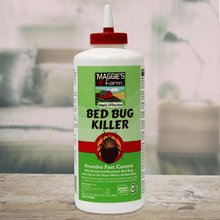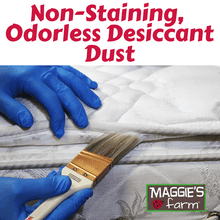DIRECTIONS FOR USE
Always read label directions and precautions prior to use. It is a violation of Federal law to use this product in a manner inconsistent with its labeling.
Use Sites: In and around residential, multi-family, agricultural, and recreational buildings, garages, transport vehicles, and other manmade structures.
General Information: Maggie’s Farm Simply Effective Bed Bug Killer is a desiccant dust that has no odor and will not stain. When pests contact Maggie’s Farm Simply Effective™ Bed Bug Killer, the product clings to their exoskeleton and absorbs the waxy coating, causing death from dehydration.
Application Rates and Methods: Apply at a rate of 2 ounces per 100 square feet. In attics and crawlspaces, apply at a rate of 1 lb per 1000 square feet. Use the puffer bottle to apply a light, visible film. A craft or paintbrush is useful for pushing dust into cracks and crevices, and into tufts and folds of mattresses and cushions.
Bed Bug Treatment: Remove bedding and take the bed apart. Treat the interior framework, joints and cracks in the bed frame. Treat the mattress and box spring, paying particular attention to tufts, folds and edges, and the interior framework of the box spring. Remove wall-mounted headboards and treat the back side. Treat picture frames, moldings, hollow furniture legs, cracks, and crevices, along baseboards, and any areas with visible signs of infestation, including rugs and carpet. Treat upholstered furniture by removing or lifting (if possible) the cushions and treating the undersurface. Treat the interior framework, cracks and joints of the furniture, and the folds, tufts, and edges of cushions and other upholstered areas. Do not treat toys and stuffed animals with product. Treat wall voids by removing electrical switch plate covers to allow access, but don’t apply dust directly in electrical boxes. Apply about ¼ oz of dust to each accessible void.
Flea, Lice and Tick Treatment: Treat kennels, pet bedding/rest areas, floor and floor coverings, cracks behind molding and baseboards and other areas where pests may harbor.
Pantry and Fabric/Clothes Beetles and Moths: Treat cracks, crevices and along the edges of cupboards, closets, pantries, shelving units and storage. Treat voids beneath drawer units by removing the lower drawers and treating the well. Treat the voids beneath shelving units or cabinets by removing the kickplate or drilling small access holes in the kickplate. Treat under rugs and along the edges of carpets and baseboards and other infested areas to control carpet beetles.
General Pest (Ants, Cockroaches, Firebrats, Silverfish, Spiders, Mites) Treatment: Treat attics, crawl spaces, trash closets, utility closets, behind baseboards, around the perimeter of dropped ceilings, in hollow furniture legs; under and behind bedding, appliances, and vending machines; in wall voids and voids under and behind cabinets, sinks, and tubs; in drawer wells, garbage chutes, pipe chases, weep holes in brick or siding, elevator pits, around drains, around electrical conduits and in cracks and crevices where insects may harbor. Focus application in areas where insects or their signs are seen.
Application tips for certain use sites follow:
- In the attic, be sure to get dust near the eaves and vent pipes where insects often first enter, as well as around any pipes or potential access points between the attic and the main structure.
- When treating cabinetry areas, if there is no gap between the lower cabinets and the kickplate, then small holes can be drilled to access the voids. Escutcheon plates around pipes can also be pulled back to allow access to voids.
- The bottom drawers in kitchen and bathroom cabinets can be removed and dust applied into drawer wells. No dust should be left exposed when drawers are replaced.
- Electrical switch plate covers can be removed to allow access to voids, but dust shouldn’t be applied directly in electrical boxes.
- If there are cracks between baseboards, cabinets, doorframes, hinges, counters or trim, and walls, these cracks can be lightly dusted with product. If practical, these areas can be sealed once insect problems have been eliminated to help prevent future problems.
- Insects need moisture, so kitchen and bath areas and areas immediately surrounding them, and any other damp areas should be carefully inspected and treated if necessary.












